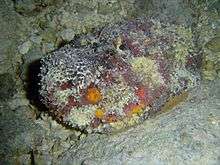Venomous fish


Venomous fish produce a strong toxin harmful to humans (called venom) which they deliver by means of a bite, sting, or stab. This results in an envenomation. As a contrast, poisonous fish also produce a strong toxin, but they do not bite, sting, or stab to deliver the toxin. Instead they are poisonous to eat because the human digestive system does not destroy the toxin they contain in their body.[1] Venomous fish don't necessarily cause poisoning if they are eaten, since the digestive system often destroys the venom.[1]
A 2006 study found that there are at least 1200 species of venomous fish.[2][3] There are more venomous fish than venomous snakes. In fact, there are more venomous fish than the combined total of all other venomous vertebrates.[2] Venomous fish are found in almost all habitats around the world, but mostly in tropical waters. They wound over 50,000 people every year.[4]
They carry their venom in venom glands and use various delivery systems, such as spines or sharp fins, barbs, spikes and fangs. Venomous fish tend to be either very visible, using flamboyant colors to warn enemies, or skilfully camouflaged and maybe buried in the sand. Apart from the defense or hunting value, venom helps bottom dwelling fish by killing the bacteria that try to invade their skin. Few of these venoms have been studied. They are yet to be tapped resource for bioprospecting to find drugs with medical uses.[3]
Treatment for venom stings usually includes the application of heat, using water at temperatures of about 45 °C (113 °F), since heat breaks down most complex venom proteins.
Examples
- The most venomous known fish is the reef stonefish.[5][6] It has a remarkable ability to camouflage itself amongst rocks. It is an ambush predator that sits on the bottom waiting for prey to approach. Instead of swimming away if disturbed, it erects 13 venomous spines along its back. For defense it can shoot venom from each or all of these spines. Each spine is like a hypodermic needle, delivering the venom from two sacs attached to the spine. The stonefish has control over whether to shoot its venom, and does so when provoked or frightened.[3] The venom results in severe pain, paralysis and tissue death, and can be fatal if not treated. Despite its formidable defenses, stonefish have predators. Some bottom feeding rays and sharks with crushing teeth feed on them, as does the Stokes' seasnake[7]
- The lionfish is a venomous coral reef fish.[8] Unlike stonefish, a lionfish can release venom only if something strikes its spines. Although not native to the U.S. coast, lionfish have appeared around Florida and have spread up the coast to New York. They are attractive aquarium fish, sometimes used to stock ponds, and may have been washed into the sea during a hurricane. Lionfish can aggressively dart at scuba divers and attempt to puncture their facemask with their venomous spines.[3]
- The stargazer buries itself and can deliver electric shocks as well as venom.[9] It is a delicacy in some cultures (cooking destroys the venom), and can be found for sale in some fish markets with the electric organ removed. They have been called "the meanest things in creation"[3]
- Stingrays can sting and cause an injury with their stinger. Such envenomations can occur to people who wade in shallow water and tread on them. This can be avoided by shuffling through the sand or stamping on the bottom, as the rays detect this and swim away. The stinger usually breaks off in the wound. It is barbed, so it can easily penetrate but not so easily be removed. The stinger causes local trauma from the cut itself, pain and swelling from the venom, and possible later infection from bacteria. Occasionally severed arteries or death can result.[10]
See also
References
- 1 2 Poisonous vs. Venomous fish: What’s the difference? Reef Biosearch. Retrieved 17 July 2009.
- 1 2 Smith WL and Wheeler WC (2006) "Venom Evolution Widespread in Fishes: A Phylogenetic Road Map for the Bioprospecting of Piscine Venoms" Journal of Heredity 97 (3):206-217.
- 1 2 3 4 5 Grady, Denise Venom Runs Thick in Fish Families, Researchers Learn New York Times 22 August 2006.
- ↑ Venomous Fish Outnumber Snakes, LiveScience, 22 August 2006.
- ↑ Froese, Rainer and Pauly, Daniel, eds. (2009). "Synanceja verrucosa" in FishBase. July 2009 version.
- ↑ "The Stonefish – The Deadliest Fish in The World", Virginia Wells, Petplace.com.
- ↑ Reef Stonefish, Synanceia verrucosa (Bloch & Schneider, 1801) Australian Museum. Retrieved 21 July 2009.
- ↑ Froese, Rainer and Pauly, Daniel, eds. (2009). "Pterois volitans" in FishBase. July 2009 version.
- ↑ Froese, Rainer and Pauly, Daniel, eds. (2009). "Uranoscopus sulphureus" in FishBase. July 2009 version.
- ↑ Taylor, Geoff (March 2000). "Toxic fish spine injury: Lessons from 11 years experience" (pdf). Journal of the South Pacific Underwater Medicine Society. South Pacific Underwater Medicine Society. 30 (1): 7–8. ISSN 0813-1988. OCLC 16986801. Retrieved 10 June 2015.
